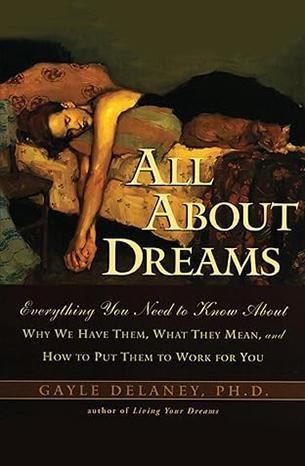In Your Dreams: A New Kind of Dream Dictionary
“At last, an intelligent “dream dictionary” by an internationally renowned dream expert who has battled the dictionary approach to dream interpretation for 50 years. Gayle provides tools that you can personalize to uncover the unique meaning in ‘your’ dream images and themes.” My Publisher’s description.
I want to tell you more! You’ve probably heard the complaint that “If you tell your dream to five different interpreters, you will get five different interpretations!” Well, that is true if the interpreters fail to ask the dreamer key descriptive questions BEFORE asking for, or worse, suggesting connections with waking life!
Since the 1970s I have pleaded with so many bookstore owners to refuse to carry Dream Dictionaries and on TV shows like Opera and GMA, I have looked right into the camera and said: “You know those Dream Dictionaries that tell you what a frog or car in your dream means? Throw them out!” The book sellers always respond, “We know how you feel, Gayle, and agree, but we sell so many of these; people just want a simple answer even if they usually comment that pat answers don’t seem to ring true in THEIR own dreams and lives.”
Such books have kept the study of dreams in the Dark Ages for too long! How can anyone other than you know why you dreamt of that green car of your sister’s, or what it means to dream of a horse just like the white speckled mare in your dream? Unless you learn how to interview yourself or, if you are very lucky to have a friend or therapist who knows how to draw out from you these crucial details by asking you to describe these images, you will never fully benefit from the clues they offer to the richness and specificity of your dreams.
In Your Dreams has an unusual organization. Arranged by theme and particular images like Cars, Sexy or threatening aggressors, dogs and cats, Mafia, Mothers, and Flying, Finding Lost Treasure, Visiting New Houses, Being Lost, or Teaching Others How to Fly in Their Dreams. My goal was to demonstrate, again and again, that even the most common of dreams are highly individualized by the context of the dream action and feelings they evoke in the dreamer. These details serve to help the dreamer understand something important in his current life experience. You can go straight to the image or theme of almost any of your dreams, but what you find inn this book is ….
Section one of each entry is:
VARIATIONS OF THIS DREAM which describes several of numerous versions I have heard of this dream element or theme. Most will soon recognize that the vast differences of these dreams simply COULD NOT mean the same thing!
Section Two:
WHAT OTHERS HAVE SAID gives brief descriptions of how several therapists, grandmothers, and theorists have interpreted similar dreams—differently enough to make you laugh!
Section Three:
WHAT MY CLIENTS HAVE SAID in which you will read two short dream variations which when interviewed came up with idiosyncratic interpretations light years away for the prescribed meanings in section two, and from each other!
Section Four:
WHAT DO YOU SAY? QUESTIONS YOU CAN ASK YOURSELF about any dream of this image or theme.
So, this book is meant as a bait and switch, a benevolent Trojan Horse-kind of Dream Dictionary!
If puzzled dreamer just can’t resist the urge to look in a book and find a particular image listed with an interpretation all done without the dreamer’s input, this book offers a tricky twist: Look up mafia men, and you will see very different ways others have interpreted them, then you find questions you can ask yourself to find out what why YOU chose this image for your particular dream—at a particular moment in your life.
Reading these examples will give you a feel for how to conduct your own dream interviews, devise your own questions, custom tailored to your dream, and why it is best to put aside hand-me-down interpretations.
I hope reading these examples will give you a feel for how to conduct your own dream interviews, devise your own questions, custom tailored to your dream, and why it is best to put aside hand-me-down interpretations.
As I looked over the redwood valley to San Francisco writing my book, I imagined it to sell mostly to beginners; but I was surprised to hear from therapists who wrote to say they kept the book beside them in therapy sessions so that when a patient brought up a dream, the therapist could look up the key dream elements or category of element, and immediately find a few questions they could ask their client that would drill down into the special particulars of almost any dream image. You see, most therapists have never been trained to ask the dreamer questions before jumping to conclusions about how the Dreamer had experienced and felt about a given dream image in a methodical way. In Your Dreams became their tool kit of interview questions! Other readers use the book not only for their own dreams, but to interview their friends! Enjoy!


